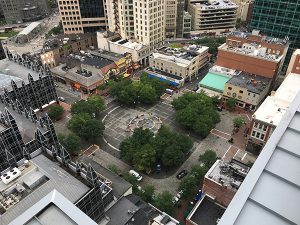
Historic Tour of Downtown Pittsburgh: A Fresh Perspective

Looking like so many stars set against the night sky, this image of the skylight at the center of The Pennsylvanian’s rotunda is seen from the perspective of writer Emily Barrie, during her recent exploration of Downtown Pittsburgh’s landmark architecture.
The following article was written by Emily Barrie, a tenth-grade student at Upper St. Clair School High School in Allegheny County. The idea for this article originated when Emily called our offices to express her interest in learning more about the historic built environment and volunteering for PHLF. Because of the Covid-19 pandemic, our staff was working from home at the time. We suggested that Emily explore Downtown Pittsburgh using our guidebook, “Exploring Pittsburgh,” and then write about her experience. Her fresh perspective highlights the enduring vitality of our city’s architecture, no matter the time or circumstances. To explore on your own this summer, please order one of our guidebooks at https://phlf.org/landmarks-store/ or download a self-guided tour at https://phlf.org/education-department/self-guided-walking-tours/.
Since 2020, our world has gone through a chaotic and challenging time due to the Covid-19 global pandemic, which led to the closure of many of our favorite buildings and businesses. Still, there are many exciting places to visit right in our very own city that can fulfill your need to leave the house. I have always loved history in general, but discovering the history and culture of my own city has been especially rewarding. This past year, I toured Downtown Pittsburgh’s historic landmarks, including The Pennsylvanian, buildings in the Cultural District and Market Square, Smithfield United Church, Point State Park, and the Omni William Penn Hotel.
Regardless of their status on tourist destination lists, the sites showed me, as a Pittsburgh-area resident, an underappreciated and beautiful side of my city— one I hope more people take the time to learn about.
 The first landmark I visited was The Pennsylvanian, historically known as the Pennsylvania Railroad’s Union Station. Located at 1100 Liberty Avenue, it was completed in 1903 and designed by D.H. Burnham & Company (Chicago). From a distance, it resembled any other stately building in Downtown Pittsburgh. Because of its small size (compared to nearby skyscrapers), my first instinct was to drive past its buff brick and terra cotta-ornamented facade.
The first landmark I visited was The Pennsylvanian, historically known as the Pennsylvania Railroad’s Union Station. Located at 1100 Liberty Avenue, it was completed in 1903 and designed by D.H. Burnham & Company (Chicago). From a distance, it resembled any other stately building in Downtown Pittsburgh. Because of its small size (compared to nearby skyscrapers), my first instinct was to drive past its buff brick and terra cotta-ornamented facade.
But once I pulled into the parking lot, I realized that this beautiful landmark was underappreciated. The most significant feature of the building is its rotunda. Standing under it, I was amazed by how small I felt compared to the building as I craned my neck to admire its many details.
The arches were outlined with soft yellow lights, and there was a decorative tablet in each corner with the name of one of the railroad’s four main stations during the early 1900s ––Pittsburg, New York, Chicago, and Philadelphia. A feature that stood out to me was the name of Pittsburgh, spelled “Pittsburg,” because the building was built during the time (between 1891 and 1911) when the U.S. Board on Geographic Names insisted that Pittsburgh drop its “h” in an effort to standardize names throughout the nation.
 I loved the center of the rotunda with its opaque glass skylight and intricate design. The overall scale and detailing of the rotunda transported me back to a grander time. Standing under it, I could picture the horse-drawn carriages and early automobiles dropping off passengers. Much has changed since then. The former station building was remodeled in 1988 into offices and apartments. The Pennsylvanian is a gorgeous gem in Downtown Pittsburgh!
I loved the center of the rotunda with its opaque glass skylight and intricate design. The overall scale and detailing of the rotunda transported me back to a grander time. Standing under it, I could picture the horse-drawn carriages and early automobiles dropping off passengers. Much has changed since then. The former station building was remodeled in 1988 into offices and apartments. The Pennsylvanian is a gorgeous gem in Downtown Pittsburgh!
The next stop on my exploration was the Cultural District, an area of fourteen square blocks that lie parallel to the Allegheny River between Stanwix and Tenth streets. I had been to the Cultural District a plethora of times during my eight years of living in Pittsburgh— I am a huge lover of musicals––so the Benedum Center for Performing Arts, Heinz Hall, Byham Theater, and Harris Theater were all treasured places to me. Each place gives me the feeling of wanting to dress up, to show up in my finest.
Just walking through the Benedum’s doors and looking up at the breathtaking grand staircase leading up to the balcony, or seeing the crystal chandeliers suspended from the intricately decorated ceiling at Heinz Hall, makes me feel as if I am going to an exclusive and opulent event. Sometimes, while attending a performance, I even catch myself staring at an artistic building detail instead of the performance itself. While performances are offered many times a year at these theaters to packed audiences, the buildings always make me feel as if each time is special, and that I, too, should wear my finest attire. Overall, the interiors of all the theaters in the Cultural District are gorgeous and make seeing a performance that much more enjoyable.
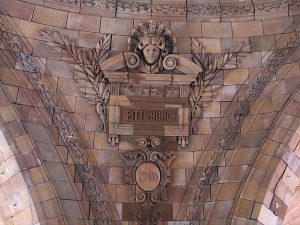 Every time I visit the Cultural District though, it’s either at dusk or at nighttime, and I am rushing to my seat for a performance. With Covid-19, and now the lack of musicals occurring, I discovered that it was such a joy just to walk around the Cultural District in the daytime.
Every time I visit the Cultural District though, it’s either at dusk or at nighttime, and I am rushing to my seat for a performance. With Covid-19, and now the lack of musicals occurring, I discovered that it was such a joy just to walk around the Cultural District in the daytime.
On my recent walking tour, I saw more of the buildings and noticed how they related to one another in the built environment. I felt completely safe as I strolled down Penn Avenue and past a handful of sculptures and statues, even if several of them were shaped like eyes, watching me walk into the Agnes R. Katz Plaza. Unperturbed, I rested on one of those benches and looked closely at the facade of the Benedum Center for the Performing Arts. The lights, which illuminate the building at night, were turned off. For the first time, I could see how much work and intricacy was put into the pale terra cotta and tan brick building.
The terra cotta formed into the shape of a rising sun or a shell far above the windows, with even more ornamental patterns inside this arch. In modern buildings, there are not as many ornamented features, which tells me (and other alert observers) that many of the Cultural District buildings were created well before the 1950s and 1960s. Furthermore, during the day, I was able to read the message on the marquee of the Benedum: “Stay Safe and Healthy.” This made me smile, and it added a sense of relevance to the historic building, which otherwise could have been overlooked if driven by without knowledge of what life lives inside. The Cultural District is a great place to visit either at night or during the day, but whenever you go, I guarantee you will appreciate the beauty and welcoming aspect of the buildings and outdoor spaces.
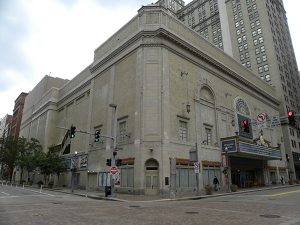 I next visited Market Square, nestled in the heart of Pittsburgh. Of all the places I have mentioned thus far, Market Square was by far the most bustling and alive. I was only able to stay a short time due to limited parking, but it was enough for me to get a good sense of how much it had to offer us: its history (laid out in 1784), delicious restaurants, and breezy, flowing urban design. This area gave off positive energy to everyone within its borders. But I wanted to know more about this area’s past.
I next visited Market Square, nestled in the heart of Pittsburgh. Of all the places I have mentioned thus far, Market Square was by far the most bustling and alive. I was only able to stay a short time due to limited parking, but it was enough for me to get a good sense of how much it had to offer us: its history (laid out in 1784), delicious restaurants, and breezy, flowing urban design. This area gave off positive energy to everyone within its borders. But I wanted to know more about this area’s past.
At first, I was a bit confused as to where this history could be found, in a place so full of growth and new restaurants. Then I realized that if I looked closely, history was everywhere. The first piece of history I saw was a plaque labeled “Historic Landmark: Site of Bear Tavern (1827) Oyster House C. 1871-1971.” This was on the wall of the Original Oyster House. It was an average-looking brick building, but after this initial discovery, it did not take me long to find another restaurant in a historic building. Primanti Brothers, a true Pittsburgh classic, occupied a building constructed relatively soon after Pittsburgh’s Great Fire of 1845. It looked similar to the Oyster House building (they both were shorter buildings, with dentil molding under the eaves), which suggested to me that the Primanti Brothers building was constructed in a similar, but more ornamental, style (with window hoods, for example).
Market Square has nowhere near the feeling of historic grandeur that The Pennsylvanian or the Cultural District displays, but it is a beautiful space to remember the history of everyday Pittsburgh. While standing in the middle of the square, I felt like slowly turning my head to take everything in, that the public spirit and purpose of Market Square had never changed since it was laid out. It is a place for people to gather, eat good food, and enjoy each other’s company—whether that be in the Eighteenth, Nineteenth, Twentieth, or Twenty-first Centuries. It is a must-see for history and non-history lovers alike.
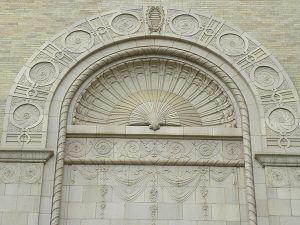 Between Market Square and the Cultural District was my next stop to see the Smithfield United Church of Christ. Designed by Henry Hornbostel and completed in 1926, it is located on very busy Smithfield Street. Parking was difficult to find. The building was draped in netting since the exterior needs to be restored, but that did not draw away from the beauty and history the church offers to the viewer.
Between Market Square and the Cultural District was my next stop to see the Smithfield United Church of Christ. Designed by Henry Hornbostel and completed in 1926, it is located on very busy Smithfield Street. Parking was difficult to find. The building was draped in netting since the exterior needs to be restored, but that did not draw away from the beauty and history the church offers to the viewer.
My first thought upon seeing the church was about the way the building filled up every square inch of space allotted to it. Also, the church doors were wide and welcoming. It had a medieval look to it as well, with the open-work, aluminum spire at the top (which can only be really appreciated from a distance because of its height). In reading about the church, I learned this structure was designed in the eclectic Gothic Revival style. The church is famous for its series of stained-glass windows commemorating historical events and Pittsburgh scenes. I think stained glass is such a gorgeous feature of churches: the time and effort people have dedicated to creating it shows the importance of religious structures in our country’s history. There are a lot of churches in downtown Pittsburgh, which does make it hard to pick which one to explore next!
Rather than hunt for another religious structure in my guidebook, though, I decided to walk all the way to Point State Park. I enjoyed exploring the park the most. The vastness of the park makes it seem never-ending. Entering the park, I felt as if a little adventure was waiting just for me. I walked down the long footpath filled with a variety of people, from young families pushing strollers to men and women jogging. The park gave off positive and safe energy. After walking under the aptly named Portal Bridge (1961-63), my sightline opened up to a breathtaking view of the fountain and, in the near distance, the three rivers: the Monongahela, Ohio, and Allegheny. The foreground was anchored by a large, nicely mowed, grassy area where people were having picnics and throwing frisbees. The rivers were beautiful to look at, but knowing their past made them all that more lovely.
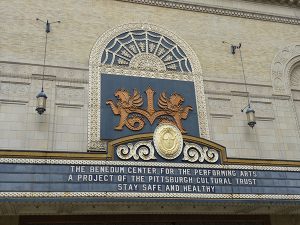 These three rivers were crucial in the French and Indian War (1754-1763), which became a global conflict between England and France that was known as the Seven Years’ War (1756-1763). Whoever controlled trade in the Ohio Country, controlled settlement further west, and the Point, where the Ohio River began, was of strategic importance. Because these rivers were so important for maintaining control over the region, I thought that there must be some sort of fortification here, right? Yep, the very next thing I noticed was a reconstructed bastion of the British Fort Pitt, and nearby, the outline of the French Fort Duquesne. Although the forts were no longer standing, the Fort Pitt Block House has survived for 257 years and is open to the public. At school, the Seven Years War and Pittsburgh’s role in it are discussed so students are familiar with the names of these two forts. Still, seeing the outlines of the actual forts located at the Point where the three rivers meet made the whole conflict more real.
These three rivers were crucial in the French and Indian War (1754-1763), which became a global conflict between England and France that was known as the Seven Years’ War (1756-1763). Whoever controlled trade in the Ohio Country, controlled settlement further west, and the Point, where the Ohio River began, was of strategic importance. Because these rivers were so important for maintaining control over the region, I thought that there must be some sort of fortification here, right? Yep, the very next thing I noticed was a reconstructed bastion of the British Fort Pitt, and nearby, the outline of the French Fort Duquesne. Although the forts were no longer standing, the Fort Pitt Block House has survived for 257 years and is open to the public. At school, the Seven Years War and Pittsburgh’s role in it are discussed so students are familiar with the names of these two forts. Still, seeing the outlines of the actual forts located at the Point where the three rivers meet made the whole conflict more real.
I also visited the Fort Pitt Museum, whose exhibitions and gift shop were engaging and enlightening. When I left the museum, it was getting dark, so I decided to head back. I walked a different way, though, closer to the river, and noticed there were plenty of bikers on this paved path, which showed me the huge variety of things you can do in Point State Park. By the time I reached home, I was definitely worn out from all the walking, but it was worth it! Point State Park is the type of place where you can return again and again and each time, discover more about Pittsburgh, both past and present.
The next time I found room in my schedule to explore downtown Pittsburgh, I took time to learn more about the Omni William Penn Hotel (Janssen & Abbott, architects, 1914-16; Janssen & Cocken, architects, 1926-29; Joseph Urban [New York], 1929). I entered the hotel from Mellon Square (itself a quiet respite from the city’s bustle) along William Penn Way. Above the entrance is a canopy with the inscription “William Penn Hotel,” along with different emblems, such as the Penn family crest. Beneath the canopy is bellhops who are there at the ready to take luggage, park cars and help customers. They were dressed in uniforms from a bygone era. Between the architecture of the hotel and the attendants’ attire, I was immediately pulled back into a different time. As the bellhop pushed the revolving door for me and I walked into the “swanky” lobby, I felt like I was a 1920s heiress who was staying at the hotel. Sparkling chandeliers hung from the ceiling, large arches provided glimpses into the branching hallways, and a wall clock ticked away the time. The lobby’s stateliness reminded me of the clocks found in another type of historic Pittsburgh landmark—our grand train stations. I walked through the lobby, passing the beautiful historic restaurant, and traveled down the first hallway I saw. The hallway was filled with history. There were pictures, documents, paintings, and sculptures in glass cases that all related to the founding of Pittsburgh and to the opening of the William Penn Hotel.
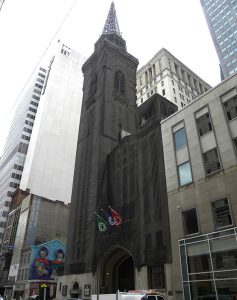 Looking up, I noticed a sign hanging from the ceiling saying “Speakeasy,” with an arrow pointing to the lower level of the hotel. The word “speakeasy” rang a bell in my mind from history class as a place where alcohol was illegally sold during Prohibition in the 1920s. I wanted to know more, so I found the closest stairwell and quickly descended. Then, I dashed down the hall past the William Penn Ballroom and spotted two doors with “Speakeasy” written on them. I was disappointed to find that I could not open the doors because the room, which is a working bar, was closed until later that evening. Nonetheless, I was able to peer through the green-tinted windows of the door and observe an almost perfectly replicated speakeasy of the 1920s. I found it so neat that the room continued to serve its original purpose. I took some photos and explored the surrounding area a bit more before deciding I had definitely achieved my purpose in visiting the hotel, which was to explore its history and appreciate its present beauty. It is a charming hotel for tourists, and a must-see for Pittsburgh residents: it really does make you feel like you are living in a completely different time, with a far more luxurious life!
Looking up, I noticed a sign hanging from the ceiling saying “Speakeasy,” with an arrow pointing to the lower level of the hotel. The word “speakeasy” rang a bell in my mind from history class as a place where alcohol was illegally sold during Prohibition in the 1920s. I wanted to know more, so I found the closest stairwell and quickly descended. Then, I dashed down the hall past the William Penn Ballroom and spotted two doors with “Speakeasy” written on them. I was disappointed to find that I could not open the doors because the room, which is a working bar, was closed until later that evening. Nonetheless, I was able to peer through the green-tinted windows of the door and observe an almost perfectly replicated speakeasy of the 1920s. I found it so neat that the room continued to serve its original purpose. I took some photos and explored the surrounding area a bit more before deciding I had definitely achieved my purpose in visiting the hotel, which was to explore its history and appreciate its present beauty. It is a charming hotel for tourists, and a must-see for Pittsburgh residents: it really does make you feel like you are living in a completely different time, with a far more luxurious life!
My travels in downtown Pittsburgh to visit The Pennsylvanian, the Cultural District, Market Square, Smithfield United Church of Christ, Point State Park, the Omni William Penn Hotel, and other sites were rewarding experiences that showed me how history is present everywhere. The beauty in visiting historical landmarks is not just about enjoying the architecture of the buildings, but also about being in the place where significant events have occurred. This self-guided tour taught me that history is truly in every part of my city—from every hotel to every park.
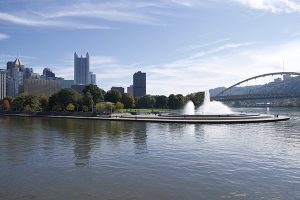 I highly encourage everyone to take part in a similar walking tour. You’ll learn to appreciate just how rich we are in Pittsburgh, thanks to the efforts by many to preserve architectural landmarks and local history! During my walking tours, I did not spend even a single penny to visit any site, with the exception of a modest admission fee for the Fort Pitt Museum, which also shows just how affordable it can be to get out and explore your community. There is one way you can spend money, though, that will benefit the sites and Pittsburgh as a whole. Most historic buildings are either underfunded or in need of restoration or constant repairs for their upkeep, so donations can help these sites survive. You also can show some love for our city’s past and present by taking a historic tour this summer. I guarantee you will not be disappointed!
I highly encourage everyone to take part in a similar walking tour. You’ll learn to appreciate just how rich we are in Pittsburgh, thanks to the efforts by many to preserve architectural landmarks and local history! During my walking tours, I did not spend even a single penny to visit any site, with the exception of a modest admission fee for the Fort Pitt Museum, which also shows just how affordable it can be to get out and explore your community. There is one way you can spend money, though, that will benefit the sites and Pittsburgh as a whole. Most historic buildings are either underfunded or in need of restoration or constant repairs for their upkeep, so donations can help these sites survive. You also can show some love for our city’s past and present by taking a historic tour this summer. I guarantee you will not be disappointed!

